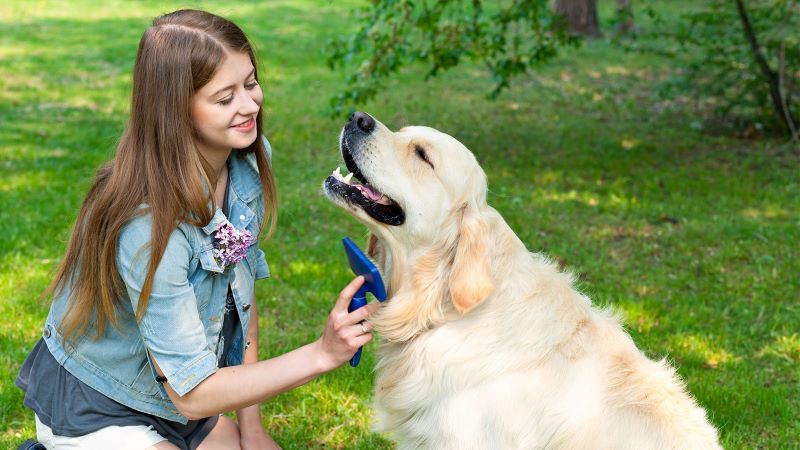Dog hair is simply a part of life for me, and to be honest, I hardly notice it. Perhaps because I have lived most of my life with a golden retriever? There are certainly times when I am entertaining or just tidying up when I’d like not to see the “tumblehair” as we call it, collecting in the corners. And it is kind of embarrassing to head out to run errands in black pants only to realize I am covered in wavy yellow hairs. ‘Tis the season for dogs to begin dropping their winter coats, so let's talk tips to manage the shedding.
Brush your dog often
Although this one can seem like a no-brainer, really how often is often? And who needs one more thing to add to their to-do list? Let’s put a positive spin on this one. Think of the time you spend brushing your dog as self-care for him/her and bonding time for the two of you. It’s important to make time for your pet, and grooming is a great way to spend this time! According to Mari Rozanski of Plush Pups Boutique and Grooming Huntingdon Valley, Pennsylvania, once a week is adequate. Try pairing your dog’s weekly brushing with something else you already do weekly. If you take your dog on a long walk on Sunday afternoon, follow it with a good brushing. Does your dog dislike being brushed? You may not have the right tools. Ask your vet to recommend the best brush for your dog’s coat. A bristle-brush is usually best for short-haired dogs, and a “rake” (we like The Furminator) is best for long-haired dogs. For a dog with long, wavy fur, try a pin brush.
Consider your dog’s diet
Make sure your dog consumes a healthy well-balanced diet and plenty of fresh water. “A poor diet will not supply all the nutrients a pet needs to grow and maintain a healthy coat. Adequate amounts of high-quality protein and fat, particularly essential fatty acids, are needed to reduce excessive shedding,” says Dr. Jennifer Coates, a veterinarian in Fort Collins, Colorado. Adding flaxseed oil to your dog’s food is a great way to improve your dog’s skin and coat but be sure to consult your vet before doing so. Many dog foods contain naturally rich sources of omega-3 and omega-6 fatty acids such as whole flaxseed because of the health benefits. Too much flaxseed can result in diarrhea, so be careful that your dog receives only the recommended dose.
It is also important that your dog drinks plenty of water. As the temperature outside climbs, be sure to have plenty of water on hand if you are out and about with your dog. We like the Highwave AutoDogMug for road trips and long walks. You may also want to treat your dog to these yummy Pupsicles!
Bathe your dog regularly
Bathing your dog frequently and brushing at least once a week can make a huge difference when it comes to shedding. Scrubbing your dog well will keep his/her coat healthy and free of dirt and parasites. It also helps remove clotted or matted fur. Make sure to use a shampoo and conditioner specially formulated for dogs, as pH balance for a dog is different than a human. Also, allow your dog to dry naturally, and comb his coat well after the bath. Avoid using a high heat blow dryer which can wreak havoc on your dog’s sensitive skin. Bathing at home using the correct tools is great, but many dogs should visit the groomer every 4-6 weeks for a thorough session. See 5 Tips From Your Groomer to help make grooming sessions as simple as possible.
Set yourself up for success
Dog hair comes with the territory if you have decided to make a furry four-legged friend a part of your family. But there are some easy steps you can take to avoid becoming frustrated with the hair. Keep a vacuum and lint roller at the ready. We have lint rollers stashed by the front door and in our cars. If you allow your dog on your couch or bed, put a sheet down on top so you can easily shake it out or wash it from time to time. You may also want to change right before heading out the door, so you limit the amount of time your clothes collect hair.
If your dog is shedding more than usual…
These tips will help you handle shedding, as long as your dog is healthy. If you see an increase in shedding (that is not explained by the change of seasons), you should consult your vet. Shedding accompanied by patchy hair loss, itchiness, and/or skin lesions can be signs of a serious illness. Making and keeping annual vet wellness checkups is paramount to the health and wellbeing of your dog. When your vet knows your dog’s “normal,” it is easier to spot a problem. PetPartners can help offset the cost of vet bills—consider enrolling in pet insurance to help with both unexpected vet bills and routine care so you can have peace of mind knowing you are doing everything you can to keep your pet healthy.

